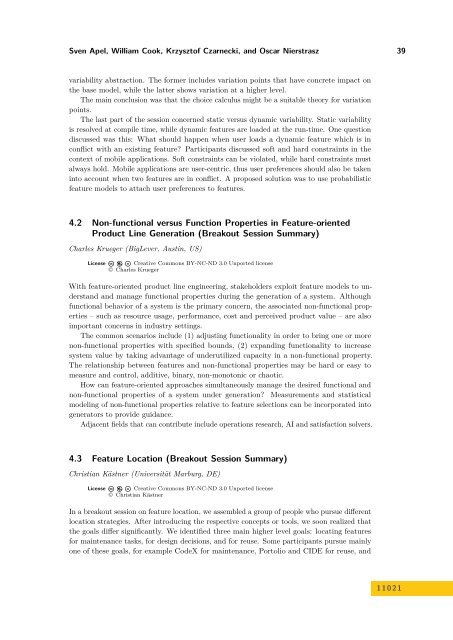Volume 1, Issue 1, January 2011 - DROPS - Schloss Dagstuhl
Volume 1, Issue 1, January 2011 - DROPS - Schloss Dagstuhl
Volume 1, Issue 1, January 2011 - DROPS - Schloss Dagstuhl
Create successful ePaper yourself
Turn your PDF publications into a flip-book with our unique Google optimized e-Paper software.
Sven Apel, William Cook, Krzysztof Czarnecki, and Oscar Nierstrasz 39<br />
variability abstraction. The former includes variation points that have concrete impact on<br />
the base model, while the latter shows variation at a higher level.<br />
The main conclusion was that the choice calculus might be a suitable theory for variation<br />
points.<br />
The last part of the session concerned static versus dynamic variability. Static variability<br />
is resolved at compile time, while dynamic features are loaded at the run-time. One question<br />
discussed was this: What should happen when user loads a dynamic feature which is in<br />
conflict with an existing feature? Participants discussed soft and hard constraints in the<br />
context of mobile applications. Soft constraints can be violated, while hard constraints must<br />
always hold. Mobile applications are user-centric, thus user preferences should also be taken<br />
into account when two features are in conflict. A proposed solution was to use probabilistic<br />
feature models to attach user preferences to features.<br />
4.2 Non-functional versus Function Properties in Feature-oriented<br />
Product Line Generation (Breakout Session Summary)<br />
Charles Krueger (BigLever, Austin, US)<br />
License Creative Commons BY-NC-ND 3.0 Unported license<br />
© Charles Krueger<br />
With feature-oriented product line engineering, stakeholders exploit feature models to understand<br />
and manage functional properties during the generation of a system. Although<br />
functional behavior of a system is the primary concern, the associated non-functional properties<br />
– such as resource usage, performance, cost and perceived product value – are also<br />
important concerns in industry settings.<br />
The common scenarios include (1) adjusting functionality in order to bring one or more<br />
non-functional properties with specified bounds, (2) expanding functionality to increase<br />
system value by taking advantage of underutilized capacity in a non-functional property.<br />
The relationship between features and non-functional properties may be hard or easy to<br />
measure and control, additive, binary, non-monotonic or chaotic.<br />
How can feature-oriented approaches simultaneously manage the desired functional and<br />
non-functional properties of a system under generation? Measurements and statistical<br />
modeling of non-functional properties relative to feature selections can be incorporated into<br />
generators to provide guidance.<br />
Adjacent fields that can contribute include operations research, AI and satisfaction solvers.<br />
4.3 Feature Location (Breakout Session Summary)<br />
Christian Kästner (Universität Marburg, DE)<br />
License Creative Commons BY-NC-ND 3.0 Unported license<br />
© Christian Kästner<br />
In a breakout session on feature location, we assembled a group of people who pursue different<br />
location strategies. After introducing the respective concepts or tools, we soon realized that<br />
the goals differ significantly. We identified three main higher level goals: locating features<br />
for maintenance tasks, for design decisions, and for reuse. Some participants pursue mainly<br />
one of these goals, for example CodeX for maintenance, Portolio and CIDE for reuse, and<br />
1 1 0 2 1













